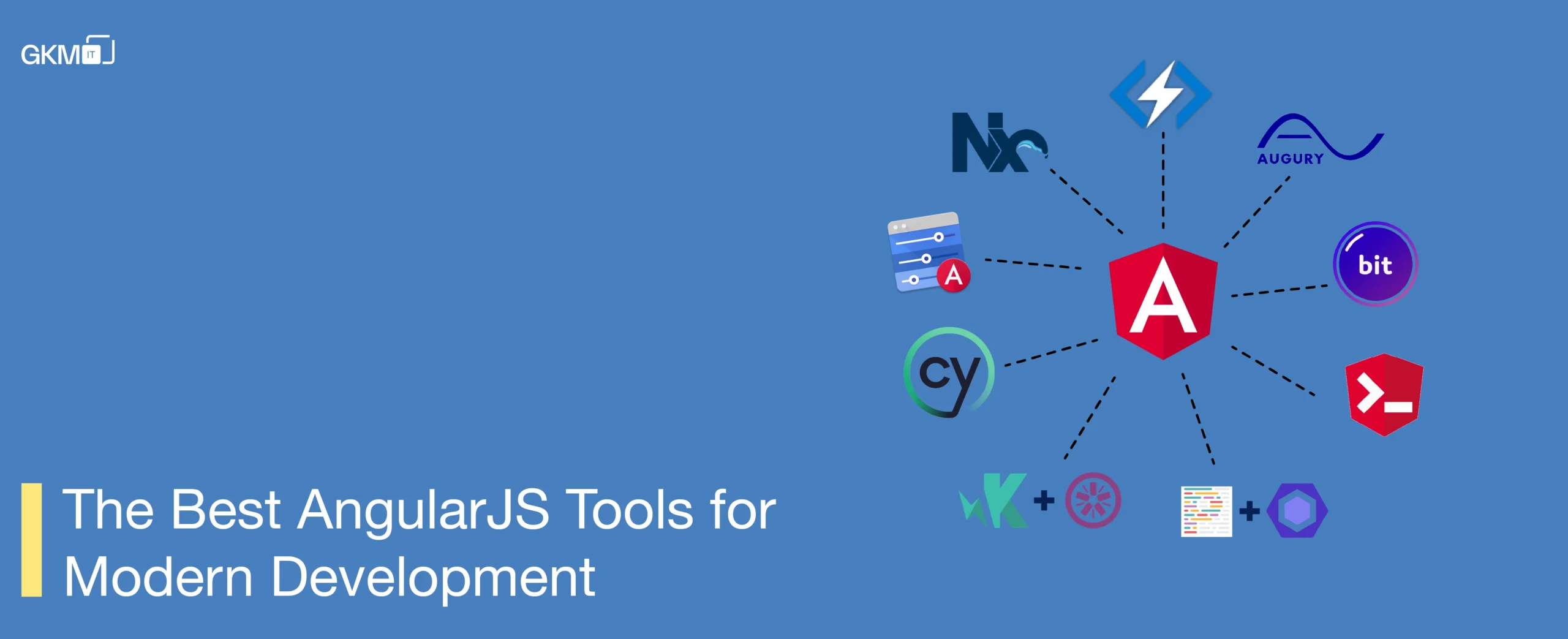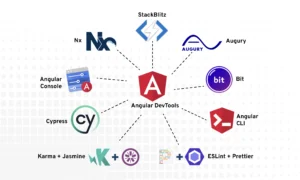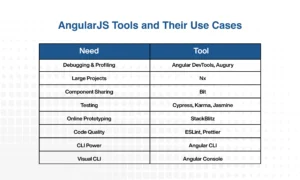
10 Angular Tools That Are Redefining Development in 2025
Angular has been around for a long time. It’s no longer the new kid on the block, with React and Vue taking over the hype, but it still reigns as the adult in the room. It’s structured, scalable, and still the best option for enterprise-grade applications.
But here’s the thing: Angular is not enough by itself.
When you know how to resource, Angular becomes more powerful. In 2025, we can say that Angular development is smarter, faster, and, in some cases, a lot more fun – if you know what you’re doing.
So, whether you’re creating a one-page portfolio or a fully fledged SaaS dashboard, these are valuable AngularJS tools to use.

1. Angular DevTools: Your Debugging X-Ray Vision
Forget combing through console logs like a digital paleontologist. AngularJS DevTools provides you with a crystal-clear look into your component tree, change detection cycles, and state. When it comes to insights into your app’s internals, it feels like you can see through the skin of your application.
Why this matters in 2025:
- It’s created and maintained by the Angular core team.
- It incorporates new standalone component patterns.
- It enables you to collect performance insights that are component-scoped.
If you have been operating on primitive browser tools, consider this your glow-up. For any serious Angular developer, AngularJS DevTools are non-negotiable.
2. Nx: The Genius for Big Projects
Let’s say you’re not just building an application. You’re building an ecosystem. Perhaps it’s micro frontends, or it’s multiple applications that share libraries. Nx handles everything and treats it as a first-class citizen. Nx is the robust monorepo toolkit that is a virtual necessity for large-scale Angular development.
New in 2025:
- First-class support for Vite (finally!).
- A plugin ecosystem for AI-based code suggestions.
- New and improved performance monitoring tools.
So if you still have multiple repos, then Nx will change the way you think about project architecture.
3. StackBlitz: Angular in the Browser, For Real
Imagine this: you’re on a call, bouncing ideas around, and someone suggests a UI change. With StackBlitz, you can prototype it in seconds, in your browser. No install. No setup. Just Angular, TypeScript, and magic.
It’s not an illusion. StackBlitz is now using WebContainers to run complete Node.js environments in-browser, which means quick previews, live collaboration, and a development experience that feels local, even if it isn’t.
4. Augury: Deep Debugging, Visually Done Right
Augury is more than a fancy way of displaying your component tree. It gives you insights into your Angular app. Visualize your routing, look at where services are injected, and identify state transitions, all without having to read the console.
In 2025, it is sharper, lighter, and directly integrated with Angular DevTools for a better experience.
5. Bit: Reusability That Makes Sense
The reality is that most Angular teams are wasting time recreating buttons, forms, and tables. Bit eliminates that wasted time by turning your components into versioned, standalone, shareable building blocks. It’s like npm, but for your own UI library.
What developers love about it:
- Publish Angular components from any project.
- Share across teams with complete CI/CD.
- Visual documentation for each component.
If you have a large or distributed team, Bit can save the developers. Easily the best Angular tool of the year.
6. Angular CLI: The Command Line Superpower
The Angular CLI’s always had strength, but in 2025, it’s gone next-level. Scaffolding components, generating modules, running builds, and configuring SSR all from one line!
What’s new:
- Native SSR support
- Greater access to testing tools like Cypress
- Custom scaffolding for standalone APIs
It’s not a helper anymore. It’s your workflow!
7. ESLint + Prettier: Code That Cleans Itself
Let’s be real, nobody wants to be arguing about code formatting, so let your tools do it for you.
ESLint is giving you analysis for bugs, anti-patterns, and bad practices in Angular, and Prettier is making it look good while doing it. Together, they provide harmony to your codebase.
Bonus: ESLint in 2025 now comes out of the box with support for Angular’s newer standalone and signal-based APIs.
8. Karma + Jasmine: The Old Guard Still Holds Up
They are older but still strong. If you are only concerned with unit testing conventions using Angular’s defaults, Karma and Jasmine are as good as they have ever been. The tooling is faster, and integration with CI pipelines like GitHub Actions has been seamless.
That said, here is the real take: if you are starting from zero, I’d look to replace them with Cypress or Jest. More on that shortly.
9. Cypress: End-to-End Testing Without Hassles
Testing full user flows? Use Cypress. It runs in the browser, watches your app like a hawk, and gives you video playback when things go south. It’s everything Protractor would have wanted to be.
Some upgrades (in 2025) include:
- Component-level testing (yes, even with Angular)
- Snapshot testing for UI regressions
- Smart retries in CI
If you have ever spent an entire day troubleshooting flaky E2E tests, Cypress will feel like redemption.
10. Angular Console (Optional, But Slick)
There are times when the terminal is just too cold and cryptic; that’s what Angular Console fixes. It is a GUI for Angular CLI. Point, click, and generate, with no memorization of commands.
It is perfect for junior developers or product engineers who want to contribute without learning the whole Angular CLI command zoo.
Final Thoughts: The Stack That Works in 2025
The modern Angular Developer’s work doesn’t just involve writing TypeScript. You’re debugging state, testing flows, managing shared libraries, and practicing hygiene within your code. That comes down to choosing and using the right Angular development tools, and you’ve already won half the battle!
Here’s a practical summary:

In 2025, Angular is still a strong bet for scalable front-end development service. Angular may not be trendy in the Twitter sense, but it is as relevant as it has ever been when it comes to building real, scalable, fast front ends. Use it with these AngularJS tools, and you have a dev experience that is smooth, powerful, and maybe even fun.
Related Blogs:
The 12-Factor Approach and App Methodology
GitHub Copilot – A New Tool That Writes Its Own Code. Is the Future Here?
Frequently Asked Questions
Q1. Which AngularJS tools are best for debugging?
To debug your setup, AngularJS Batarang and Augury are the best of the AngularJS dev tools. They provide Angular developer tools to visually inspect your application in real time, as well as a scope inspector and performance profiler. At GKM IT, we use the best Angular tools when considering Angular development projects; it helps us to develop Angular more efficiently and solve any issues faster for every Angular developer.
Q2. How do I choose the right AngularJS tool for my project?
Choose AngularJS tools depending on the size of your project, testing requirements, and level of debugging. Find Angular development tools that fit your workflow. At GKM IT, we assess and execute the best Angular tools for your stack, making the Angular development process smoother and more productive for every Angular developer.
Q3. Which AngularJS tools improve code quality the most?
Linting tools such as TSLint and ESLint, in conjunction with AngularJS development tools such as Protractor and Karma, will greatly improve overall code quality. GKM IT’s Angular developer team employs these Angular developer tools religiously for producing clean, maintainable, scalable code on every Angular development project.
Q4. What are the best testing tools for AngularJS in 2025?
In 2025, Jasmine, Karma, and Protractor continue to remain the top AngularJS tools for testing. All these Angular development tools include unit, E2E, and integration testing. GKM IT uses these best Angular tools in CI/CD pipelines to ensure that the development of Angular using a stable, test-first approach begins on the first day.
Q5. What are the risks of using outdated AngularJS tools?
Outdated AngularJS devtools can create security vulnerabilities, slow performance, and inflict compatibility issues. It effectively stops any technology innovation in Angular. At GKM IT, we help clients modernize their toolchains, allowing Angular developers to work on projects indefinitely with the newest, secured, and efficient Angular developer tools, which results in a well-performing project everyone can enjoy.